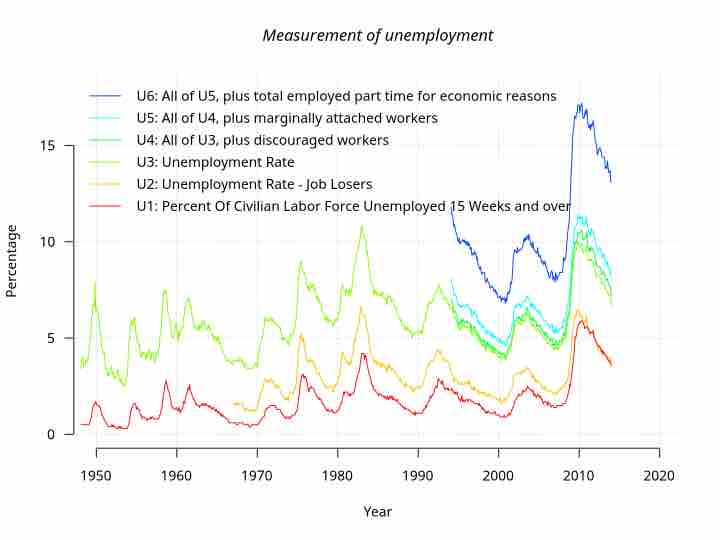Unemployment Rate
Unemployment occurs when people are without work and are actively seeking employment. In an economy, the labor force is the actual number of people available for work. Economists use the labor force participation rate to determine the unemployment rate.
Unemployment can be broken down into three types of unemployment:
- Cyclical unemployment: occurs when there is not enough aggregate demand in the economy to provide jobs for everyone who wants to work.
- Structural unemployment: occurs when the labor market is unable to provide jobs for everyone who wants to work. There is a mismatch between the skills of the unemployed workers and the skills necessary for the jobs available.
- Frictional unemployment: the time period between jobs when a worker is looking for a job or transitioning from one job to another.
Measuring Unemployment
The U.S. Bureau of Labor Statistics measures employment and unemployment for individuals over the age of 16. The unemployment rate is measured using two different labor force surveys.
- The Current Population Survey (CPS): also known as the "household survey" the CPS is conducted based on a sample of 60,000 households. The survey measures the unemployment rate based on the ILO definition.
- The Current Employment Statistics Survey (CES): also known as the "payroll survey" the CES is conducted based on a sample of 160,000 businesses and government agencies that represent 400,000 individual employees.
The unemployment rate is also calculated using weekly claims reports for unemployed insurance. The government provides this data. The unemployment rate is updated on a monthly basis.
Six Measures of Unemployment
The U.S. Bureau of Labor Statistics uses six measurements when calculating the unemployment rate. The measures range from U1 - U6 and were reported from 1950 through 2010 . They calculate different aspects of unemployment. The measures are:

Unemployment Rate
The U.S. Bureau of Labor Statistics used the six employment measures to calculate the unemployment rate in the United States from 1950 to 2010.
- U1: the percentage of labor force unemployed for 15 weeks or longer.
- U2: the percentage of labor force who lost jobs or completed temporary work.
- U3: the official unemployment rate that occurs when people are without jobs and they have actively looked for work within the past four weeks.
- U4: the individuals described in U3 plus "discouraged workers," those who have stopped looking for work because current economic conditions make them think that no work is available for them.
- U5: the individuals described in U4 plus other "marginally attached workers," "loosely attached workers," or those who "would like" and are able to work, but have not looked for work recently.
- U6: the individuals described in U5 plus part-time workers who want to work full-time, but cannot due to economic reasons, primarily underemployment.